Appendix O: Indigenous Rights Based Framework Timeline – TRC, UNDRIP and Reports
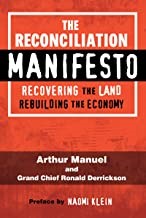
This timeline borrows from The Reconciliation Manifesto: Recovering the Land, Rebuilding the Economy (pp. 48–56) by Arthur Manuel and Grand Chief Ronald Derrickson, published by James Lorimer and Company Ltd. ISBN: 9781459409668
Back to Indigenous Inclusion in Employment
May 8, 2006
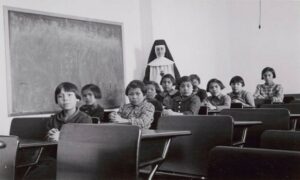
Indian Residential Schools Settlement (IRSSA)
The Indian Residential Schools Settlement (IRSSA) was the result of the TRC call for inquiry into the Residential School system, which was a network of boarding (and day) schools run by Christian churches and funded by the Department of Indian Affairs (Federal Government of Canada). The last residential school operated by the Canadian government, Gordon Indian Residential School (Wikipedia, n.d.) in Saskatchewan (Wikipedia, n.d.), was closed in 1996. The total compensation granted was $3.126 billion, with over 86 000 people entitled to compensation. Indigenous children were forcibly removed from their homes, and the Indian Act (Wikipedia, n.d.) mandated attendance with goals to assimilate Indigenous children. The schools perpetrated sexual abuse, physical abuse, and general harm, and between 3,200 and 6,000 students died while attending these schools — a testament to the harms perpetrated on those who attended. The resulting intergenerational trauma has impacted Indigenous Peoples — from those who attended, to the children and grandchildren. The network of schools has been described as a system of oppression and cultural genocide, and over 150,000 children attended across Canada. Children who attended were separated from their homes, subject to abuse, experienced cultural loss, and lost their traditional languages.
- Timeline of Residential Schools (CBC News, 2008)
- A History of Residential Schools (CBC News, 2021)
- AFN Indian Residential Schools (AFN, n.d.)
- Read more on Wikipedia (Wikipedia Editors, n.d.)
- Winnipeg Public Library (Winnipeg Public Library, n.d.)
September 13, 2007
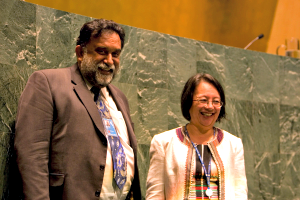
UN General Assembly Enacts UNDRIP
The United Nations Declaration on the Rights of Indigenous Peoples (UNDRIP) was adopted by the General Assembly on Thursday, 13 September 2007, by a majority of 144 states in favour, 4 votes against (Australia, Canada, New Zealand and the United States) and 11 abstentions (Azerbaijan, Bangladesh, Bhutan, Burundi, Colombia, Georgia, Kenya, Nigeria, Russian Federation, Samoa and Ukraine).
June 11, 2008
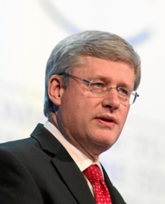
Prime Minister Steven Harper’s Apology
The Steven Harper Apology to Indian Residential School Survivors (https://www.rcaanc-cirnac.gc.ca/eng/1100100015644/1571589171655), a year after the Indian Residential School Settlement, which recognizes that the absence of an apology had been an impediment to healing and reconciliation for Indigenous Peoples, started off an era in of Truth and Reconciliation.
The official apology was instrumental in bringing better awareness of the need for Reconciliation and education of Canadians of the dark history of oppressive practices of the Canadian government that has impacted the health and wellbeing of Indigenous Peoples.
A snippet from the official apology: “A cornerstone of the Settlement Agreement is the Indian Residential Schools Truth and Reconciliation Commission. This Commission presents a unique opportunity to educate all Canadians on the Indian Residential Schools system. It will be a positive step in forging a new relationship between Aboriginal peoples and other Canadians, a relationship based on the knowledge of our shared history, a respect for each other and a desire to move forward together with a renewed understanding that strong families, strong communities and vibrant cultures and traditions will contribute to a stronger Canada for all of us.”
Canadian Federal Government Apology to First Nations (Video of Harper Apology) by School District 27 Residential Schools and Reconciliation (Dec 6, 2014) on YouTube.
November 12, 2010
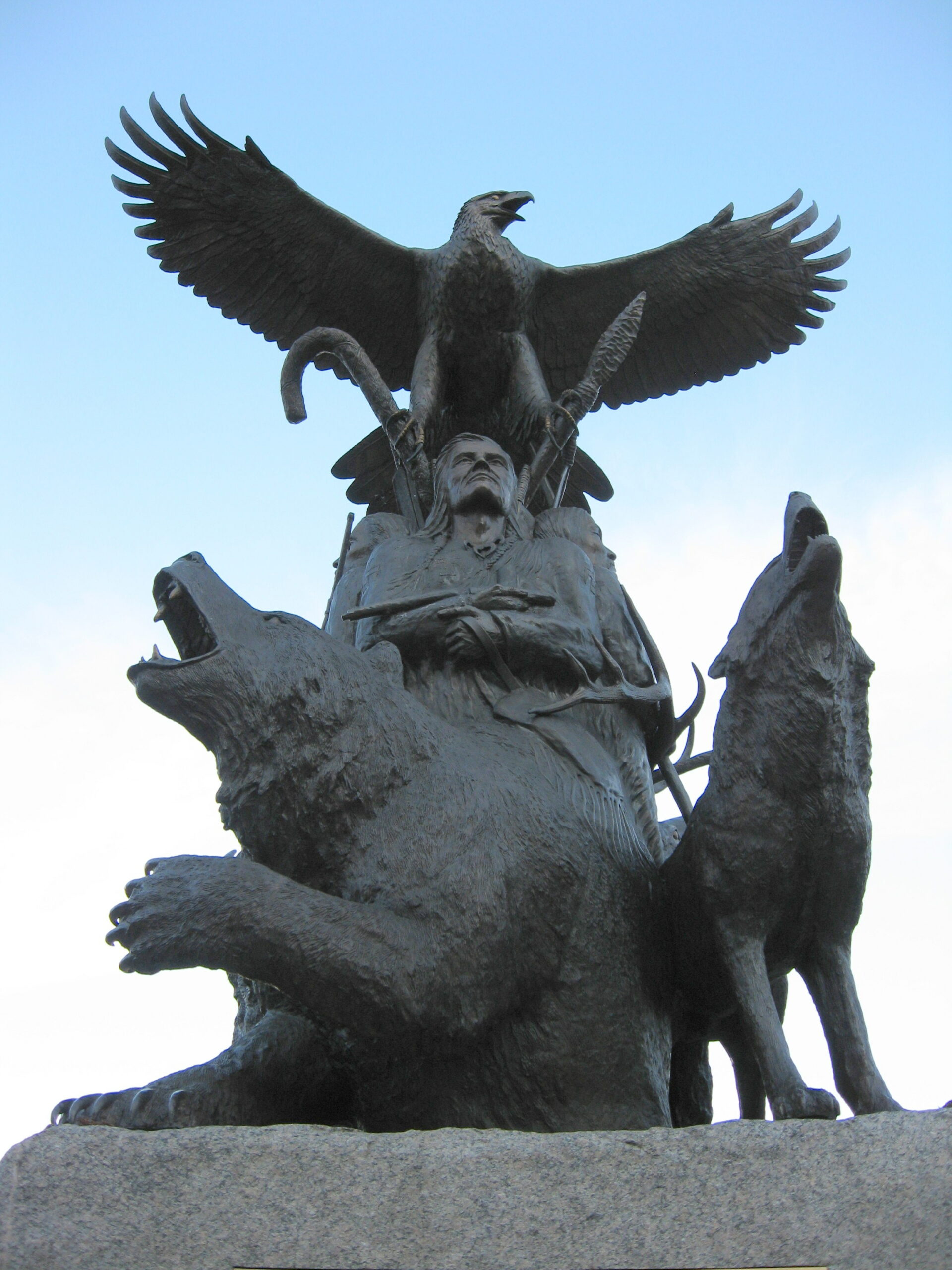
Canada Endorses UNDRIP
“Today, Canada joins other countries in supporting the United Nations Declaration on the Rights of Indigenous Peoples. In doing so, Canada reaffirms its commitment to promoting and protecting the rights of Indigenous peoples at home and abroad.
The Government of Canada would like to acknowledge the Aboriginal men and women who played an important role in the development of this Declaration.
The Declaration is an aspirational document which speaks to the individual and collective rights of Indigenous peoples, taking into account their specific cultural, social and economic circumstances.
Although the Declaration is a non-legally binding document that does not reflect customary international law nor change Canadian laws, our endorsement gives us the opportunity to reiterate our commitment to continue working in partnership with Aboriginal peoples in creating a better Canada.”
(Government of Canada, 2010)
May 28, 2015
Canada’s Policies Termed Cultural Genocide
Supreme Court Chief Justice Beverley McLachlin describes Canada’s various governmental policies an attempt to commit cultural genocide against Indigenous Peoples in what she refers to as the worst stain on Canada’s human-rights record.
Watch this video, Canada Attempted ‘Cultural Genocide’ on Aboriginals: Chief Justice Beverley McLachlin, from the Globe and Mail (2015) on YouTube.
June 2015
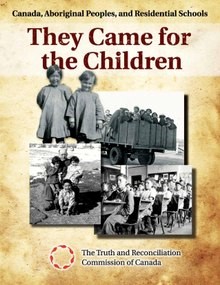
Truth and Reconciliation Commission of Canada Summary Report
The TRC Executive Summary (TRC, 2023) report included the 94 Calls to Action (TRC, 2015) and CBC News (2018) has an interactive update on the progress that has been made updated as of February 8, 2021 at Beyond 94: Truth and Reconciliation in Canada.
Of particular interest for the employment context is Call #92 which asks the corporate sector and their leadership to adopt the United Nations Declaration on the Rights of Indigenous People. The commission calls for meaningful consultation, long term sustainable opportunities from economic development projects as well as education and training for managers on the history of Indigenous people, intercultural competency, human rights and anti-racism.
- TRC Progress Report Card (TRC, 2020)
- TRC Executive Summary (TRC, 2015)
- 94 Calls to Action (TRC, 2015)
- Beyond 94: TRC in Canada (CBC News, 2018)
October 19, 2015
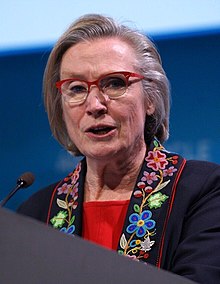
Carolyn Bennett named new Minister for Indigenous and Northern Affairs
Justin Trudeau is elected Prime Minister of Canada. He names Carolyn Bennett the new Minister for Indigenous and Northern Affairs. Minister Bennett is given a mandate letter directing her that her overarching goal will be to renew the relationship between Canada and Indigenous peoples. This was to be a nation-to-nation relationship, based on recognition, rights, respect, cooperation and partnership.
December 8, 2015
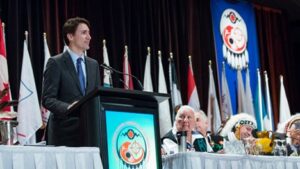
Trudeau addresses the Assembly of First Nations
Trudeau replaces a “nation-to-nation” discussion with discussions with the AFN. However, AFN does not represent the Nations — because it is not a Nation, funded almost 100% by the government.
Manuel expressed concern that the Liberals had made bold promises in the past, but had attempted to enact policies like the 1969 White Paper, which, while it talked about justice for Indigenous peoples, actually involved their assimilation into the multiculturalism of Canada.
You can read more of the text of Trudeau’s speech on the official Prime Minister of Canada, Justin Trudeau (2015) webpage, “Prime Minister Justin Trudeau delivers remarks to the Assembly of First Nations Special Chiefs Assembly” (https://pm.gc.ca/en/news/speeches/2015/12/08/prime-minister-justin-trudeau-delivers-speech-assembly-first-nations)
May 2016

Canada adopts UNDRIP
Canada officially removes its objector status to UNDRIP, almost a decade after it was adopted by the General UN Assembly. By 2016, Australia, New Zealand, and the United States of America, who had also voted against the Declaration, had reversed their positions.
However, Jim Carr, Natural Resources Minister announces that the Government of Canada is developing a ‘Canadian definition of UNDRIP’, and Justice Minister Jody Wilson-Raybould states:
“Simplistic approaches such as adopting the United Nations declaration as being Canadian law are unworkable…”
June 4, 2019
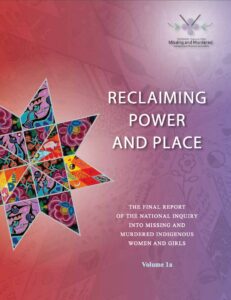
MMIWG2S Inquiry: Reclaiming Power and Place: The Final Report of the National Inquiry into Missing and Murdered Indigenous Women and Girls
The National Inquiry into Missing and Murdered Indigenous Women and Girls formally released its final report on June 3, including 231 calls for justice and the conclusion that Canada’s treatment of cases has amounted to a genocide.
- MMIW Main Page (https://www.mmiwg-ffada.ca/)
- Timeline of Key Milestones (https://www.mmiwg-ffada.ca/timeline/)
- Final Report (https://www.mmiwg-ffada.ca/final-report/)
- Final Report: Volume 1a (https://www.mmiwg-ffada.ca/wp-content/uploads/2019/06/Final_Report_Vol_1a-1.pdf)
- Final Report: volume 1b (https://www.mmiwg-ffada.ca/wp-content/uploads/2019/06/Final_Report_Vol_1b.pdf)
A new framework of rights resulted from the Inquiry: Right to Culture, Health, Security and Justice.
The National Inquiry heard 1,500 witnesses over the course of nearly three years and concluded that:
- Despite the National Inquiry’s best efforts to gather all of the truths relating to the missing and murdered, we conclude that no one knows an exact number of missing and murdered Indigenous women, girls and 2SLGBTQQIA people in Canada. Thousands of women’s deaths or disappearances have likely gone unrecorded over the decades, and many families likely did not feel ready or safe to share with the National Inquiry before our timelines required us to close registration.
- An absolute paradigm shift is required to dismantle colonialism within Canadian society, and from all levels of government and public institutions. Ideologies and instruments of colonialism, racism, and misogyny, past and present, must be rejected.
- The Canadian legal system fails to hold the state and state actors accountable for their failure to meet domestic and international human rights and Indigenous rights obligations.
- The Canadian state has displaced Indigenous women and 2SLGBTQQIA people from their traditional roles in governance and leadership and continues to violate their political rights. This has been done through concerted efforts to destroy and replace Indigenous governance systems with colonial and patriarchal governance models, such as the Indian Act, and through the imposition of laws of general application throughout Canada. Indigenous governments or bands as established under the Indian Act or through local municipal governments do not have the full trust of Indigenous women, girls, and 2SLGBTQQIA people.
- Efforts by Indigenous women, girls, and 2SLGBTQQIA people to be self-determining face significant barriers. Many Indigenous women’s advocacy organizations and grassroots organizations engaging in essential work to support survivors of violence and families of missing or lost loved ones, and working toward restoring safety, are underfunded and under supported by current funding formulas and systems.
From: CPAC In Focus
November 2021
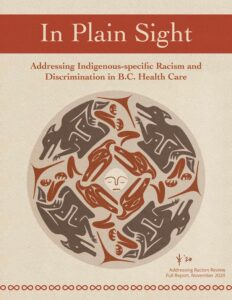
In Plain Sight: Response to Racism in Health Care
The Report In Plain Sight: Addressing Indigenous-specific Racism and Discrimination in BC Health Care was incepted when allegations of racism were surfaced in June 2020 the report describes findings of widespread systemic racism against Indigenous peoples in the B.C. health care system. It also calls for improved cultural safety in health care and increased Indigenous leadership within health services, regulators and education with recommendations for steps to solve widespread racism, and should be made to improve the safety for Indigenous Peoples in health care. One of the major concerns is that racism has prevented Indigenous Peoples from accessing health care at the same levels as other Canadians, which has wide reaching impacts on the health and wellness for Indigenous Peoples.
Back to Indigenous Inclusion in Employment
References
Assembly of First Nations (AFN). (n.d.). Residential institutions. https://www.afn.ca/residential-institutions/
CBC News. (2008, May 16). A timeline of residential schools, the Truth and Reconciliation Commission. CBC/Radio-Canada. [Last Updated: March 25, 2014]. https://www.cbc.ca/news/canada/a-timeline-of-residential-schools-the-truth-and-reconciliation-commission-1.724434
CBC News. (2021, Jun 04). CBC Explains: Your questions answered about Canada’s residential school system. CBC/Radio-Canada. [Last Updated: July 1, 2021] https://www.cbc.ca/news/canada/canada-residential-schools-kamloops-faq-1.6051632
Department of Economic and Social Affairs. (n.d.). [Les Malezer, Chairperson of the Global Indigenous Caucus, and Victoria Tauli-Corpuz, Chair of the United Nations Permanent Forum on Indigenous Issues.] Indigenous Peoples: United Nations declaration on the rights of Indigenous Peoples [photograph]. United Nations/ UN.org. https://www.un.org/development/desa/indigenouspeoples/declaration-on-the-rights-of-indigenous-peoples.html
The Globe and Mail [channel]. (2015, May 29). Canada attempted ‘cultural genocide’ on Aboriginals: Chief Justice Beverley McLachlin (video). YouTube. https://www.youtube.com/watch?v=H1L2jOtJzZg
Crown-Indigenous Relations and Northern Affairs Canada (CIRNAC). (2010). Statement of apology to former students of Indian Residential Schools. Government of Canada. https://www.rcaanc-cirnac.gc.ca/eng/1100100015644/1571589171655
Manuel, A & Derrickson, R. (2017). The Reconciliation Manifesto: Recovering the Land, Rebuilding the Economy (pp. 48–56). James Lorimer and Company Ltd.
Prime Minister of Canada, Justin Trudeau. (2015, December 8). Prime Minister Justin Trudeau delivers remarks to the Assembly of First Nations Special Chiefs Assembly in Gatineau, Quebec [digital image]. Government of Canada. https://pm.gc.ca/fr/nouvelles/discours/2015/12/08/premier-ministre-justin-trudeau-prononce-discours-devant-lassemblee
Truth and Reconciliation Commission of Canada. (2012). File:TRC Canada They came for the children.pdf [book cover image]. Wikipedia. https://en.wikipedia.org/wiki/File:TRC_Canada_They_Came_for_the_Children.pdf
Turpel-Lafond, Dr. M. E. (2020, November). In plain sight addressing Indigenous-specific racism and discrimination in B.C. health care. Addressing racism review summary report [PDF]. Government of BC. https://engage.gov.bc.ca/app/uploads/sites/613/2020/11/In-Plain-Sight-Summary-Report.pdf
Wikipedia Editors. (n.d.). George Gordon First Nation [article]. Wikipedia. https://en.wikipedia.org/wiki/George_Gordon_First_Nation [last edited on 4 October 2022]
Wikipedia Editors. (n.d.). Indian Act [article]. Wikipedia. https://en.wikipedia.org/wiki/Indian_Act [Last edited on 22 February 2023]
Wikipedia Editors. (n.d.). Saskatchewan [article]. Wikipedia. https://en.wikipedia.org/wiki/Saskatchewan [Last edited on 28 February 2023]
Winnipeg Public Library. (n.d.). Residential schools: Introduction. In Winnipeg Public Library’s Residential Schools Info Guide. City of Winnipeg. https://guides.wpl.winnipeg.ca/residentialschools
Reclaiming power and place: The final report of the national inquiry into missing and murdered Indigenous women and girls (Volume 1a). https://www.mmiwg-ffada.ca/wp-content/uploads/2019/06/Final_Report_Vol_1a-1.pdf
Media Attributions
- [cover image for] The Reconciliation Manifesto: Recovering the Land, Rebuilding the Economy (https://lorimer.ca/adults/product/the-reconciliation-manifesto/) from Lorimer. Used with permission.
- Indian Residential School, Cross Lake, Manitoba, February 1940 (https://recherche-collection-search.bac-lac.gc.ca/eng/home/record?app=fonandcol&IdNumber=4673899) in Canada. Dept. Indian and Northern Affairs on Library and Archives Canada / e011080274). [Reference: R216-3896-9-E, RG10, Volume number: 6550, File part: 2. Item ID number: 4673899 (creator): IA-1456-8]. Copyright expired.
- Stephen Harper – World Economic Forum Annual Meeting 2012 (https://www.flickr.com/photos/worldeconomicforum/6767390293/) by World Economic Forum on Flickr, is used under a CC BY NC-SA 2.0 (https://creativecommons.org/licenses/by-nc-sa/2.0/) license.
- [Les Malezer, Chairperson of the Global Indigenous Caucus, and Victoria Tauli-Corpuz, Chair of the United Nations Permanent Forum on Indigenous Issue – digital photo], in Indigenous Peoples: United Nations declaration on the rights of Indigenous Peoples on the United Nations/ UN.org website is used under the UN.org site license (https://dam.media.un.org/CMS4/Brand/Root/UN-Photo-Usage-Guidelines).
- Aboriginal War Veterans monument (close) (https://en.wikipedia.org/wiki/File:Aboriginal_War_Veterans_monument_(close).JPG) by Padraic Ryan, via Wikipedia, is used under a CC BY-SA 3.0 (https://creativecommons.org/licenses/by-sa/3.0) license.
- File:TRC Canada They Came for the Children.pdf (https://en.wikipedia.org/wiki/File:TRC_Canada_They_Came_for_the_Children.pdf) by the Truth and Reconciliation Commission of Canada, via Wikipedia, is in the public domain (https://en.wikipedia.org/wiki/en:public_domain).
- T.H. Carolyn Bennett, Minister of Crown-Indigenous Relations and Northern Affairs, Canada (https://www.flickr.com/photos/arctic_circle/37658957802/), by Arctic Circle, via Flickr, is used under a CC BY 2.0 (https://creativecommons.org/licenses/by/2.0/) license.
- Prime Minister Justin Trudeau delivers remarks to the Assembly of First Nations Special Chiefs Assembly (https://pm.gc.ca/fr/nouvelles/discours/2015/12/08/premier-ministre-justin-trudeau-prononce-discours-devant-lassemblee) from the Prime Minister’s Office (2015). This is used for Personal or Public Non-commercial Use
- File:Jody Wilson-Raybould (cropped).jpg (https://commons.wikimedia.org/wiki/File:Jody_Wilson-Raybould_(cropped).jpg) by Erich Saide,via Wikimedia Commons is used under a CC BY-SA 3.0 (https://creativecommons.org/licenses/by-sa/3.0/deed.en) license.
- [cover image for] Reclaiming power and place: The final report of the national inquiry into missing and murdered Indigenous women and girls (Volume 1a) (https://www.mmiwg-ffada.ca/wp-content/uploads/2019/06/Final_Report_Vol_1a-1.pdf) by Dee-Jay Monika Rumbolt (Snowbird), for Motherly Love;The Saa-Ust Centre, for the star blanket community art piece; & Christi Belcourt, for This Painting is a Mirror. Used with permission.
- [cover image for] In Plain Sight: Addressing Indigenous-specific Racism and Discrimination in B.C. Health Care by …. Used with permission.

